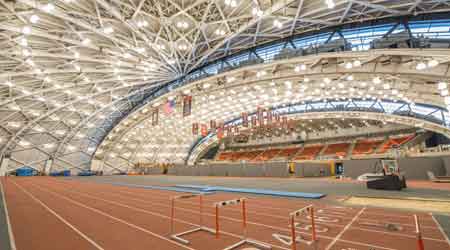Princeton University Lighting Program Embraces LEDs
Part one of a four-part article on Princeton University's LED upgrade
When Princeton University plunged into the world of LED lighting, it did so in a big way. The Ivy League institution’s goal to reduce carbon emission levels by 2020 opened the door for a lighting efficiency upgrade program that eventually will convert more than 100,000 campus lighting fixtures to LED technology and incorporate the expanded use of occupancy sensors.
The project started in March 2014 and is scheduled to wrap up in December 2017. When finished, the project will affect more than 150 campus buildings with about 6.6 million square feet. About 19 months remain in the multi-million dollar project, but so far, the university has reduced its lighting wattage by 20-60 percent  in completed buildings.
in completed buildings.
“The energy group is funding the program, and that’s the primary drive behind this,” says Brian Robertson, Aramark senior project manager for engineering and campus energy department. “We’re doing a bunch of different energy-mitigation projects on campus, and lighting was determined to be a strategy with one of the best overall paybacks. That’s why they dedicated funding for LED lighting.”
Challenges and priorities
The program represents the first significant lighting upgrade at Princeton in more than 20 years, when the university converted lamps from incandescent to fluorescent technology. LEDs are about 50 percent more efficient than their fluorescent counterparts. Many LEDs are touted to last at least 50,000 hours.
The program involves diverse types of facilities, including parking areas, athletic facilities, laboratories, lecture halls and office buildings. The program focuses mostly on buildings with more than 10,000 square feet, the campus’s largest energy users.
“We’re doing about 10 percent new fixtures and 90 percent relamping,” says Robertson. “There are a few reasons for that. One is speed. Relamping is just faster (than replacing entire fixtures). The second is labor cost. It is much less expensive to change lamps than install fixtures when required to use the $125 per hour prevailing wage labor. The lower installation costs support better paybacks. The other is flexibility. We have a lot of different requirements on campus for color temperature, and there are several staffs that have sensitivities and different requirements.
“Even though we do match lumen output of the existing lamps that we’re changing, they do appear brighter, so we’ve had requests to de-lamp.”
In addition to the increased energy savings, another positive aspect of the project comes from projected maintenance savings. Once upgrades are complete, workers will have to devote less time to replacing burned out lamps because of the extended life LEDs provide compared with their fluorescent counterparts.
“We had large lecture halls that every year we would relamp,” says Handy Seldon, a building maintenance supervisor. “Two years ago, we put in the LEDs, and not a single one has burned out. So we don’t have to scaffold it every year. The stairwells, for example, we have to scaffold to replace lamps. That costs $6,500 each time they come out.”
Other measures employed by the facilities team to help keep costs lower include:
In-house labor. “We find the benefit of having in-house labor for their flexibility, knowledge of the buildings, and experience,” Robertson says. “We can give them a product, and they basically handle the project moving forward — everything from scheduling, working with the staff to make different arrangements. They know the building and the hidden closets, and that’s a huge benefit. That’s the one big advantage to having in-house labor. We just wish there were more of them to do more buildings.”
Procuring and managing all materials in-house. “By doing that, we are able to negotiate better pricing and reach our return on investment quicker,” Robertson says. “In the industry, LEDs are still considered a frill item, even though they are becoming more commonplace. There is a luxury charge associated with LED lighting, and we’ve seen some contractors and general contractors charge 1,000 percent markups on LED fixtures. To buy them at the in-house quantities we do, we have a large savings where we can get them 75 percent cheaper sometimes than outside consumers.”
Limiting inventory. “One of the benefits with relamping is the technology gets better every day,” Robertson says. “When we first started this program, we were putting in T8s that were 22 watts, so we went from 32 watts to 22 watts. Now that 22 watts within two years is down to 15 watts. Costs keep going down and efficiency is improving, so when we put in LED lamps, we don’t like to have a large inventory of product sitting around because the next day it’s out of date and less expensive. We keep a small inventory if we need to replace a deficient lamp under warranty.”
Related Topics:















